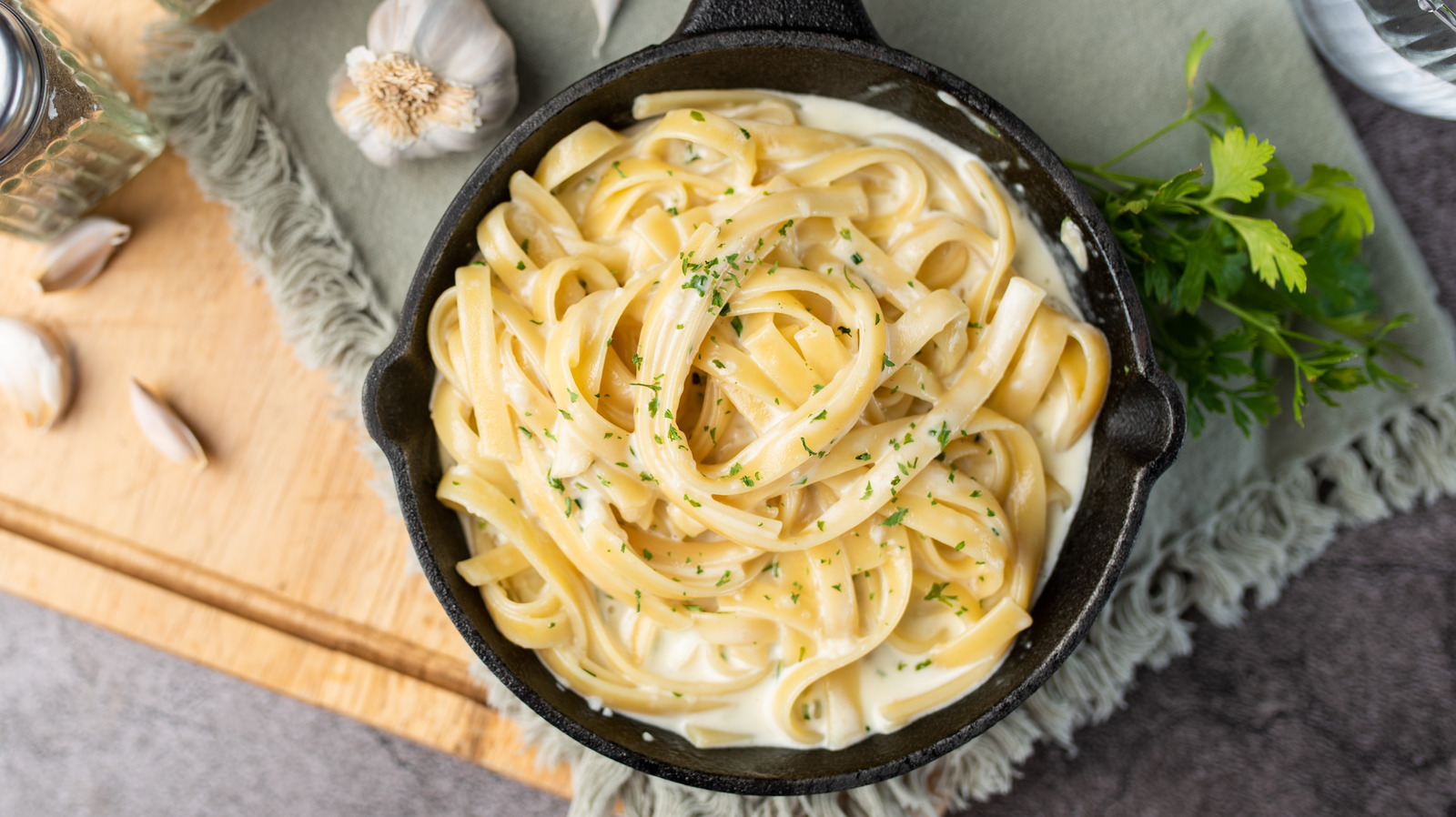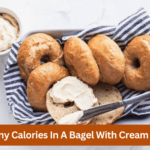In the realm of quick-fix dinners, jarred Alfredo sauce reigns supreme. Its creamy texture and rich flavor make it a convenient staple in many households. However, while convenient, jarred Alfredo sauce often lacks the depth and complexity of homemade versions. Fear not, for with a few simple tricks and additions, you can transform your jarred Alfredo sauce into a gourmet delight. In this comprehensive guide, we’ll explore various techniques and ingredients to elevate your jarred Alfredo sauce to new heights of culinary excellence.
Before diving into the realm of enhancements, it’s essential to understand the basic components of jarred Alfredo sauce. Typically, these sauces consist of cream, cheese (often Parmesan), butter, and various seasonings. While convenient, their flavor profile can sometimes fall short of homemade counterparts.
The Enhancement Arsenal
1. Garlic Infusion
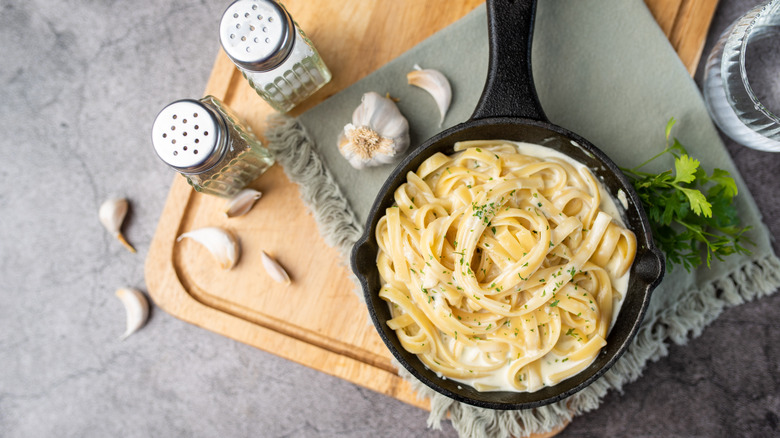
Technique:
Sautéing Method: Begin by heating a small amount of olive oil or butter in a saucepan over medium heat. Once the oil is heated, add minced garlic to the pan. Ensure the garlic is evenly distributed in the oil to prevent burning. Stir the garlic constantly for 2-3 minutes, or until it becomes fragrant and slightly golden brown. This process allows the natural oils and flavors of the garlic to be released, infusing the oil with its robust essence.
Alternative:
Garlic Powder Incorporation: If fresh garlic isn’t available or if you prefer a smoother texture in your sauce, garlic powder can be a convenient alternative. Simply add 1 teaspoon of garlic powder directly to the jarred Alfredo sauce and stir well to incorporate. This method ensures a consistent garlic flavor throughout the sauce without the need for sautéing.
Flavor Impact:
Depth and Complexity: The addition of garlic brings a depth of flavor and complexity to the sauce, enhancing its overall taste profile. The sautéing process caramelizes the garlic slightly, imparting a sweet and nutty undertone to the sauce. This infusion of flavor adds richness and dimension, elevating the jarred Alfredo sauce to a more gourmet level.
Usage Tips:
- Adjusting Intensity: The intensity of the garlic flavor can be adjusted according to personal preference. For a milder taste, sauté the garlic for a shorter duration, while a longer sautéing time will result in a more pronounced garlic flavor.
- Balancing Other Ingredients: When incorporating garlic into the sauce, consider how it interacts with other ingredients. Garlic pairs well with herbs such as parsley and thyme, as well as with the creamy richness of the Alfredo sauce itself.
- Consistency Consideration: Be mindful of the texture of the garlic in the sauce. Minced garlic adds a subtle texture, while garlic powder ensures a smoother consistency. Choose the method that best complements your desired final dish.
Culinary Creativity:
-
- Experimentation: Don’t hesitate to experiment with different varieties of garlic, such as roasted or black garlic, for unique flavor profiles. Additionally, combining garlic with other aromatic ingredients like shallots or onions can further enhance the complexity of the sauce.
- Customization: The beauty of garlic infusion lies in its versatility. Tailor the amount of garlic used to suit your taste preferences, whether you prefer a subtle hint or a bold garlic presence. Ultimately, the goal is to create a sauce that delights your palate and satisfies your culinary cravings.
2. Herbaceous Elevation
:max_bytes(150000):strip_icc()/22831-alfredo-sauce-DDMFS-4x3-36dd980adf744f8c8eab7e0636401acc.jpg)
Selection:
Freshness Matters: Opt for fresh herbs whenever possible, as they offer vibrant flavors and aromas that elevate the sauce. Common herbs used in Alfredo sauce include oregano, parsley, thyme, and chives. Each herb brings its unique characteristics to the dish, enhancing its overall complexity.
Preparation:
- Finely Chopped: To maximize the infusion of flavor, finely chop the selected herbs before adding them to the sauce. This ensures that the herbs distribute evenly throughout the sauce, imparting their essence with each bite.
- Gradual Addition: Add the chopped herbs to the sauce gradually as it heats, allowing their flavors to meld and intensify. Taste the sauce periodically to gauge the level of herbaceousness and adjust accordingly.
Flavor Impact:
- Freshness and Aroma: The addition of fresh herbs infuses the sauce with a burst of freshness and aroma, elevating its overall sensory experience. Oregano lends a savory and slightly earthy flavor, while parsley adds a bright and herbaceous note. Thyme contributes a subtle floral and citrusy undertone, while chives impart a mild onion-like flavor.
Usage Tips:
- Balance and Harmony: Consider the flavor profile of the herbs you’re using and how they complement the other ingredients in the sauce. Aim for a balanced combination that enhances the richness of the Alfredo sauce without overpowering it.
- Adjusting Quantity: The amount of herbs added to the sauce can be adjusted according to personal preference. Start with a small quantity and gradually increase until the desired flavor intensity is achieved.
- Texture Consideration: While finely chopped herbs distribute more evenly throughout the sauce, leaving some larger pieces can add textural interest to the dish. Experiment with different chopping techniques to find the perfect balance.
Culinary Creativity:
- Herb Pairings: Don’t be afraid to experiment with different herb combinations to create unique flavor profiles. For example, combining parsley and chives adds freshness and brightness, while oregano and thyme provide depth and complexity.
- Herb Infusion Techniques: Explore alternative methods of infusing herbs into the sauce, such as steeping them in warm cream or oil before adding them to the sauce. This can extract maximum flavor from the herbs and elevate the sauce to new culinary heights.
- Herb Varieties: Expand your culinary horizons by exploring lesser-known herbs or exotic varieties that can add a distinctive flair to your Alfredo sauce. From basil and cilantro to tarragon and rosemary, the possibilities are endless.
3. Creamy Indulgence
Options:
- Heavy Cream: Adding heavy cream to jarred Alfredo sauce enriches its texture and imparts a luxurious mouthfeel. The richness of heavy cream enhances the sauce’s velvety consistency, elevating it to gourmet status.
- Cream Cheese: Incorporating cream cheese into the sauce adds a tangy richness and creaminess that balances the savory flavors. The cream cheese melts seamlessly into the sauce, contributing to its velvety smoothness.
- Sour Cream: For a slightly tangy twist, sour cream can be used to enhance the creaminess of the sauce. Its subtle acidity adds depth of flavor and complexity, making the sauce more dynamic and satisfying.
Method:
- Gradual Addition: Whether using heavy cream, cream cheese, or sour cream, add these creamy elements gradually to the sauce as it heats. This allows for thorough incorporation and ensures a smooth, creamy texture throughout.
- Stirring Technique: Stir the sauce continuously as you add the creamy elements to prevent clumping and ensure even distribution. This helps to achieve a silky consistency and prevents any unpleasant texture.
Flavor Impact:
- Richness and Creaminess: The addition of heavy cream, cream cheese, or sour cream enhances the sauce’s richness and creaminess, elevating its overall indulgence factor. These creamy elements add depth and complexity to the flavor profile, making each bite a decadent delight.
- Balanced Texture: Creamy indulgence not only enhances the flavor but also improves the texture of the sauce. The smooth, velvety consistency coats the palate, creating a luscious mouthfeel that enhances the dining experience.
Usage Tips:
- Balance and Harmony: Consider the flavor profile of the creamy element you’re adding and how it complements the other ingredients in the sauce. Aim for a balanced combination that enhances the richness of the Alfredo sauce without overwhelming it.
- Adjusting Quantity: The amount of heavy cream, cream cheese, or sour cream added to the sauce can be adjusted according to personal preference. Start with a small quantity and gradually increase until the desired creaminess is achieved.
- Consistency Consideration: Be mindful of the sauce’s consistency when adding creamy elements. If the sauce becomes too thick, you can thin it out with a little chicken broth or milk. Conversely, if it’s too thin, you can thicken it with additional cheese or a cornstarch slurry.
Culinary Creativity:
- Customization: Don’t be afraid to experiment with different ratios of heavy cream, cream cheese, or sour cream to achieve your desired level of creaminess. Each creamy element offers unique flavor nuances that can be tailored to suit your taste preferences.
- Flavor Infusion: Consider infusing the creamy elements with additional flavors, such as garlic or herbs, before adding them to the sauce. This adds an extra layer of complexity and depth to the dish, elevating its flavor profile to new heights.
- Dairy Alternatives: For those with dietary restrictions or preferences, dairy-free alternatives like coconut cream or almond milk can be used as substitutes for heavy cream or cream cheese. These alternatives offer a creamy texture and rich flavor without compromising on indulgence.
4. Cheese Integration
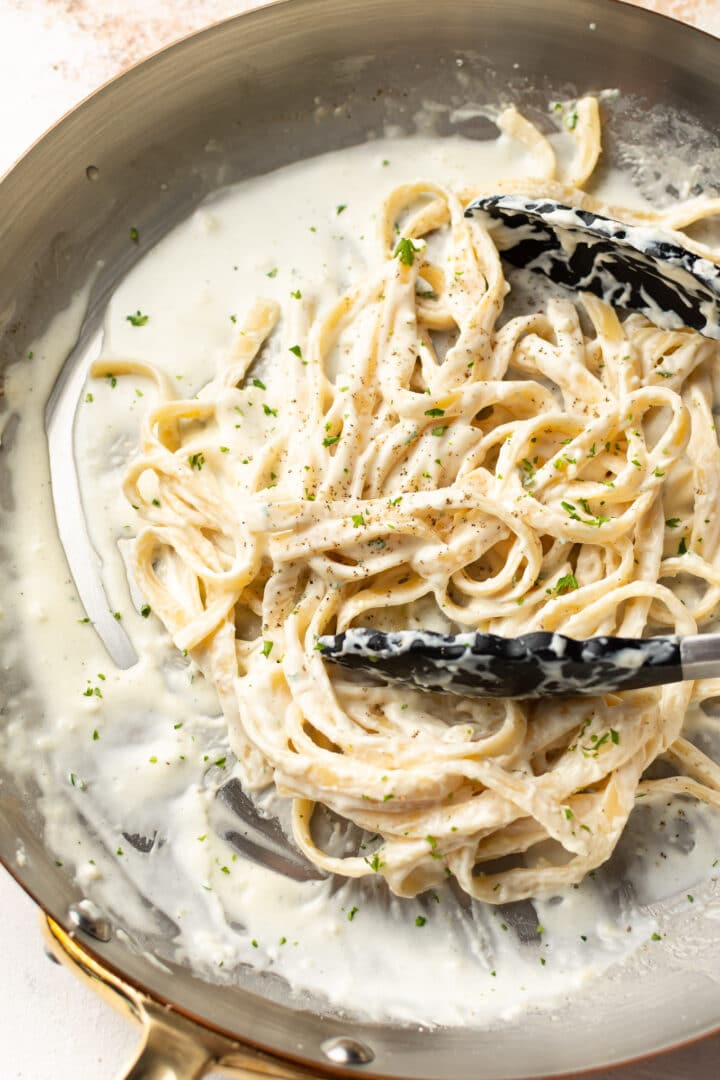
Selection:
- Parmesan: Parmesan cheese is the traditional choice for Alfredo sauce, prized for its sharp, nutty flavor and granular texture. Its bold taste adds depth and complexity to the sauce, elevating its overall richness.
- Romano: Romano cheese offers a slightly tangy and salty flavor profile, complementing the creaminess of the sauce with its robust character. Its sharpness adds a delightful contrast to the mellow sweetness of the cream.
- Asiago: Asiago cheese boasts a nutty and slightly sweet flavor, with hints of caramel and fruitiness. Its creamy texture melts beautifully into the sauce, contributing to its luxurious mouthfeel and depth of flavor.
Incorporation:
- Grated or Shredded: Grate or shred the cheese before adding it to the sauce for easy melting and even distribution. This ensures that the cheese integrates seamlessly into the sauce, creating a smooth and velvety consistency.
- Gradual Addition: Add the cheese to the sauce gradually, stirring continuously to prevent clumping and ensure thorough incorporation. This allows the cheese to melt evenly and infuse the sauce with its rich flavor.
Flavor Impact:
- Richness and Depth: Cheese integration enhances the richness and depth of flavor in the Alfredo sauce, elevating its overall taste profile. The savory notes of the cheese complement the creamy base of the sauce, creating a harmonious and indulgent culinary experience.
- Creaminess Enhancement: Cheese contributes to the creamy texture of the sauce, lending a velvety smoothness that coats the palate with each mouthful. Its melting qualities create a luxurious mouthfeel, enhancing the sauce’s appeal and satisfaction.
Usage Tips:
- Balance and Harmony: Consider the flavor profile of the cheese you’re using and how it complements the other ingredients in the sauce. Aim for a balanced combination that enhances the richness of the Alfredo sauce without overpowering it.
- Quality Matters: Use freshly grated or shredded cheese for the best results, as pre-packaged varieties may contain additives that affect the texture and flavor of the sauce. Freshly grated cheese ensures optimal meltability and flavor infusion.
- Texture Consideration: Experiment with different cheese varieties and textures to achieve the desired consistency and flavor profile in your sauce. While hard cheeses like Parmesan and Romano add a granular texture, softer cheeses like Asiago contribute to a smoother finish.
Culinary Creativity:
- Cheese Blending: Combine different cheese varieties to create unique flavor profiles and depth of taste in your Alfredo sauce. Experiment with ratios and combinations to find the perfect balance of flavors that suits your palate.
- Aged Cheese Infusion: Consider infusing the sauce with aged cheeses like aged Parmesan or aged Asiago for added complexity and depth of flavor. These cheeses bring a nuanced richness and intensity that elevates the sauce to gourmet status.
- Cheese Garnish: Sprinkle freshly grated cheese on top of the finished dish as a garnish to add visual appeal and an extra layer of cheesy goodness. This not only enhances the presentation but also intensifies the cheese flavor for a truly indulgent experience.
5. Butter Enhancement
Importance of Butter:
- Richness and Flavor: Butter is prized for its rich, creamy taste and adds a distinctively savory note to Alfredo sauce. Its natural fats and milk solids contribute to a luxurious mouthfeel and enhance the overall flavor profile of the sauce.
- Aromatic Infusion: When melted and combined with other ingredients, butter releases its aromatic compounds, imparting a subtle nutty aroma and enhancing the depth of flavor in the sauce.
- Emulsification Agent: Butter acts as an emulsifier, helping to bind the ingredients together and create a smooth, cohesive sauce. Its creamy consistency ensures that the sauce coats each strand of pasta evenly, delivering a satisfying dining experience.
Incorporation Technique:
- Melting Method: Begin by melting the butter in a saucepan over medium heat until it becomes frothy and starts to brown slightly. This process caramelizes the milk solids in the butter, intensifying its flavor and adding a hint of nuttiness.
- Garlic Infusion: For an extra layer of flavor, sauté minced garlic in the melted butter until fragrant and golden brown. This infuses the butter with the aromatic essence of garlic, enhancing the overall taste profile of the sauce.
- Gradual Addition: Once melted, gradually stir the butter into the jarred Alfredo sauce, ensuring thorough incorporation and even distribution. This allows the butter to infuse the sauce with its rich flavor and creamy texture, elevating it to gourmet status.
Flavor Impact:
- Depth and Complexity: Butter enhancement adds depth and complexity to the Alfredo sauce, elevating its flavor profile to new heights. The rich, buttery taste enhances the savory notes of the sauce and creates a luxurious mouthfeel that lingers on the palate.
- Aromatic Infusion: The aroma of melted butter and sautéed garlic permeates the sauce, tantalizing the senses and whetting the appetite. This aromatic infusion enhances the overall dining experience, making each bite a culinary delight.
Usage Tips:
- Quality Matters: Use high-quality, unsalted butter for the best results, as it offers superior flavor and texture compared to margarine or lower-quality alternatives. Fresh, premium butter ensures optimal richness and depth of flavor in the sauce.
- Balancing Act: Adjust the amount of butter added to the sauce according to personal preference, keeping in mind the desired level of richness and indulgence. Start with a small quantity and gradually increase until the desired flavor intensity is achieved.
- Garlic Consideration: When sautéing garlic in butter, be careful not to overcook it, as burnt garlic can impart a bitter taste to the sauce. Aim to sauté the garlic until it becomes fragrant and golden brown, then promptly incorporate it into the sauce for optimal flavor infusion.
Culinary Creativity:
- Herb Infusion: Experiment with adding fresh herbs like parsley, thyme, or basil to the butter as it melts, infusing the sauce with additional flavor and aroma. The herbs complement the richness of the butter and enhance the overall taste profile of the sauce.
- Compound Butter: Create your own compound butter by blending softened butter with herbs, spices, or citrus zest. Use this flavored butter to enhance the Alfredo sauce, adding a unique twist and personalizing the dish to your taste preferences.
- Butter Substitutes: For those with dietary restrictions or preferences, consider using alternative fats like olive oil or coconut oil as substitutes for butter. While these alternatives may impart slightly different flavors, they can still contribute to a rich and indulgent sauce.
6. Wine Infusion
:max_bytes(150000):strip_icc()/AR-236973-CreamyAlfredoSauce-0238-4x3-1-01e7091f47ae452d991abe32cbed5921.jpg)
Importance of Wine:
- Rich Flavor: Wine contributes rich, nuanced flavors to the sauce, enhancing its overall taste profile. The acidity and fruitiness of the wine balance the richness of the sauce, creating a harmonious and well-rounded flavor profile.
- Aromatic Complexity: Wine releases aromatic compounds when heated, adding depth and complexity to the sauce. The aroma of the wine infuses the sauce with subtle nuances, tantalizing the senses and enhancing the overall dining experience.
- Deglazing Agent: When added to the saucepan, wine can be used to deglaze the pan, releasing the flavorful browned bits (fond) stuck to the bottom. This process adds depth of flavor to the sauce and ensures that no delicious bits go to waste.
Incorporation Technique:
- Deglazing Method: Begin by adding wine to the saucepan after sautéing garlic or other aromatics. Allow the wine to simmer for 2-3 minutes over medium heat, stirring occasionally, to cook off the alcohol and concentrate its flavors.
- Combining with Sauce: Once the wine has reduced slightly, add the jarred Alfredo sauce to the saucepan and stir to combine. Continue to heat the sauce until warmed through, allowing the flavors to meld together.
- Adjusting Quantity: The amount of wine added to the sauce can be adjusted according to personal preference. Start with a small amount and gradually increase until the desired level of flavor intensity is achieved.
Flavor Impact:
- Depth and Complexity: Wine infusion adds depth and complexity to the Alfredo sauce, elevating its flavor profile to new heights. The subtle acidity and fruitiness of the wine complement the richness of the sauce, creating a harmonious and well-balanced taste experience.
- Aromatic Infusion: The aroma of the wine permeates the sauce, infusing it with subtle nuances and enhancing the overall sensory experience. The fragrant bouquet of the wine tantalizes the senses, whetting the appetite and adding to the enjoyment of the dish.
Usage Tips:
- Wine Selection: Choose a wine that complements the flavors of the sauce and your personal taste preferences. Dry white wines like Chardonnay, Pinot Grigio, or Sauvignon Blanc are commonly used in Alfredo sauce for their crisp acidity and fruity undertones.
- Quality Matters: Use high-quality wine for the best results, as it will impart superior flavor and aroma to the sauce. Avoid using cooking wine or low-quality wine substitutes, as they may contain additives that affect the taste of the sauce.
- Alcohol Reduction: To cook off the alcohol and concentrate the flavors of the wine, simmer it over medium heat for 2-3 minutes before adding the sauce. This step ensures that the sauce is infused with the essence of the wine without the harshness of raw alcohol.
Culinary Creativity:
- Wine Pairing: Experiment with different wine varieties to find the perfect pairing for your Alfredo sauce. Each wine variety brings its unique flavor profile and characteristics to the sauce, creating endless possibilities for culinary creativity.
- Wine Reduction: For a more intense flavor, consider reducing the wine before adding it to the sauce. Simmer the wine over low heat until it thickens and concentrates in flavor, then incorporate it into the sauce for a bold and robust taste experience.
- Non-Alcoholic Options: For those who prefer not to use alcohol, you can substitute wine with chicken or vegetable broth for a similar depth of flavor. Alternatively, add a splash of vinegar or lemon juice to mimic the acidity of wine without the alcohol content.
7. Seasoning Exploration
:max_bytes(150000):strip_icc()/__opt__aboutcom__coeus__resources__content_migration__simply_recipes__uploads__2017__02__2017-02-28-Alfredo-Sauce-2-6-1906af23775742229ee9f3d42a3ec7ea.jpg)
Diverse Flavor Profiles:
- Red Pepper Flakes: Add a kick of heat and complexity to the sauce with red pepper flakes. Their fiery flavor enhances the richness of the sauce and adds a tantalizing spice that lingers on the palate.
- Italian Seasoning: A blend of herbs like basil, oregano, rosemary, and thyme, Italian seasoning adds depth and complexity to the sauce. Its aromatic notes complement the creamy base of the Alfredo sauce, creating a harmonious and well-rounded flavor profile.
- Dried Herbs: Experiment with individual dried herbs like oregano, thyme, or basil to customize the flavor of the sauce. Each herb brings its unique characteristics to the dish, enhancing its overall complexity and appeal.
Incorporation Techniques:
- Gradual Addition: Add seasoning to the sauce gradually, tasting as you go to gauge the level of flavor intensity. Start with a small amount and gradually increase until the desired taste is achieved.
- Balancing Flavors: Consider how each seasoning interacts with the other ingredients in the sauce and aim for a balanced combination of flavors. Adjust the quantities of each seasoning accordingly to achieve harmony in taste.
Flavor Impact:
- Enhanced Complexity: Seasoning exploration adds depth and complexity to the Alfredo sauce, elevating its flavor profile to new heights. Each seasoning brings its unique flavor notes to the dish, creating a multi-dimensional taste experience.
- Customized Taste: By experimenting with different seasonings, you can tailor the flavor of the sauce to suit your personal preferences. Whether you prefer a hint of spice, a burst of herbs, or a touch of sweetness, seasoning exploration allows for endless culinary creativity.
Usage Tips:
- Start Small: Begin with a small amount of seasoning and gradually increase until the desired taste is achieved. Remember that it’s easier to add more seasoning than to correct an overly seasoned dish.
- Taste as You Go: Regularly taste the sauce as you add seasoning to ensure that the flavors are well-balanced. Adjust the seasoning accordingly to achieve the perfect taste profile.
- Experimentation is Key: Don’t be afraid to experiment with different seasonings and flavor combinations to discover your favorite variation of Alfredo sauce. The beauty of seasoning exploration lies in its versatility and endless possibilities.
Culinary Creativity:
- Global Flavors: Explore seasonings from different cuisines to infuse the Alfredo sauce with unique and exotic flavors. From Moroccan spices to Asian blends, the world is your culinary playground.
- Homemade Seasoning Blends: Create your own homemade seasoning blends using a variety of herbs, spices, and aromatics. Customize the blend to your taste preferences and use it to elevate the flavor of your Alfredo sauce to new heights.
- Fresh Herbs: Don’t limit yourself to dried seasonings—experiment with fresh herbs like basil, parsley, or cilantro to add brightness and freshness to the sauce. Chop the herbs finely and stir them into the sauce just before serving for a burst of flavor.
8. Broth Enrichment
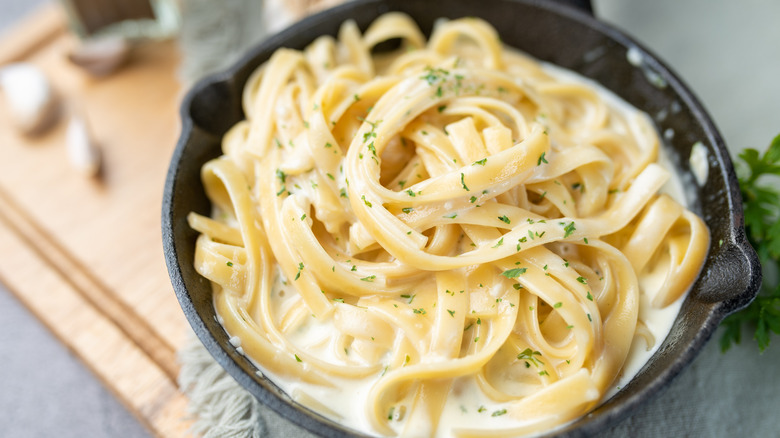
Importance of Broth:
- Flavor Infusion: Broth, whether chicken or vegetable, serves as a flavorful liquid base that infuses the sauce with savory notes and aromatic richness. The broth adds depth and complexity to the sauce, enhancing its overall taste profile.
- Moisture Enhancement: Broth provides additional moisture to the sauce, preventing it from becoming too thick or dry. The liquid content of the broth ensures that the sauce maintains a smooth and velvety consistency, coating each strand of pasta evenly.
- Versatility: Broth can be customized to suit individual taste preferences by varying the ingredients and seasonings used to make it. Whether homemade or store-bought, broth enrichment offers endless possibilities for culinary creativity.
Incorporation Technique:
- Gradual Addition: Begin by adding a small amount of broth to the saucepan, then gradually increase the quantity as needed to achieve the desired consistency and flavor intensity. Stir the sauce continuously as you add the broth to ensure even distribution.
- Simmering Method: Allow the sauce to simmer gently after adding the broth, allowing the flavors to meld together and the sauce to thicken slightly. Simmering also reduces the broth, intensifying its flavor and enhancing its richness.
Flavor Impact:
- Enhanced Depth: Broth enrichment adds depth and complexity to the Alfredo sauce, elevating its flavor profile to new heights. The savory notes of the broth complement the creamy base of the sauce, creating a harmonious and well-rounded taste experience.
- Umami Enhancement: Broth contains natural umami compounds that enhance the overall savoriness of the sauce, making it more satisfying and flavorful. The umami-rich broth adds a subtle richness and depth of flavor that lingers on the palate.
Usage Tips:
- Broth Selection: Choose a high-quality broth that complements the flavors of the Alfredo sauce and your personal taste preferences. Chicken broth is the traditional choice for Alfredo sauce, but vegetable broth can also be used for a lighter, vegetarian-friendly option.
- Homemade vs. Store-Bought: While homemade broth offers superior flavor and quality, store-bought broth can be a convenient alternative for busy cooks. Look for low-sodium or unsalted varieties to control the saltiness of the sauce.
- Seasoning Adjustment: Taste the sauce after adding the broth and adjust the seasoning accordingly to ensure that the flavors are well-balanced. Additional salt, pepper, or herbs may be needed to enhance the overall taste profile.
Culinary Creativity:
- Custom Flavor Infusion: Experiment with different types of broth, such as mushroom broth or seafood broth, to infuse the Alfredo sauce with unique and exotic flavors. Each type of broth brings its own distinct characteristics to the sauce, allowing for endless culinary creativity.
- Herb and Spice Infusion: Enhance the flavor of the broth by adding aromatic herbs and spices during the cooking process. Bay leaves, peppercorns, garlic, and thyme are popular additions that impart additional depth and complexity to the sauce.
- Broth Reduction: For a more intense flavor, consider reducing the broth before adding it to the sauce. Simmer the broth over low heat until it thickens and concentrates in flavor, then incorporate it into the sauce for a bold and robust taste experience.
9. Protein and Vegetable Integration
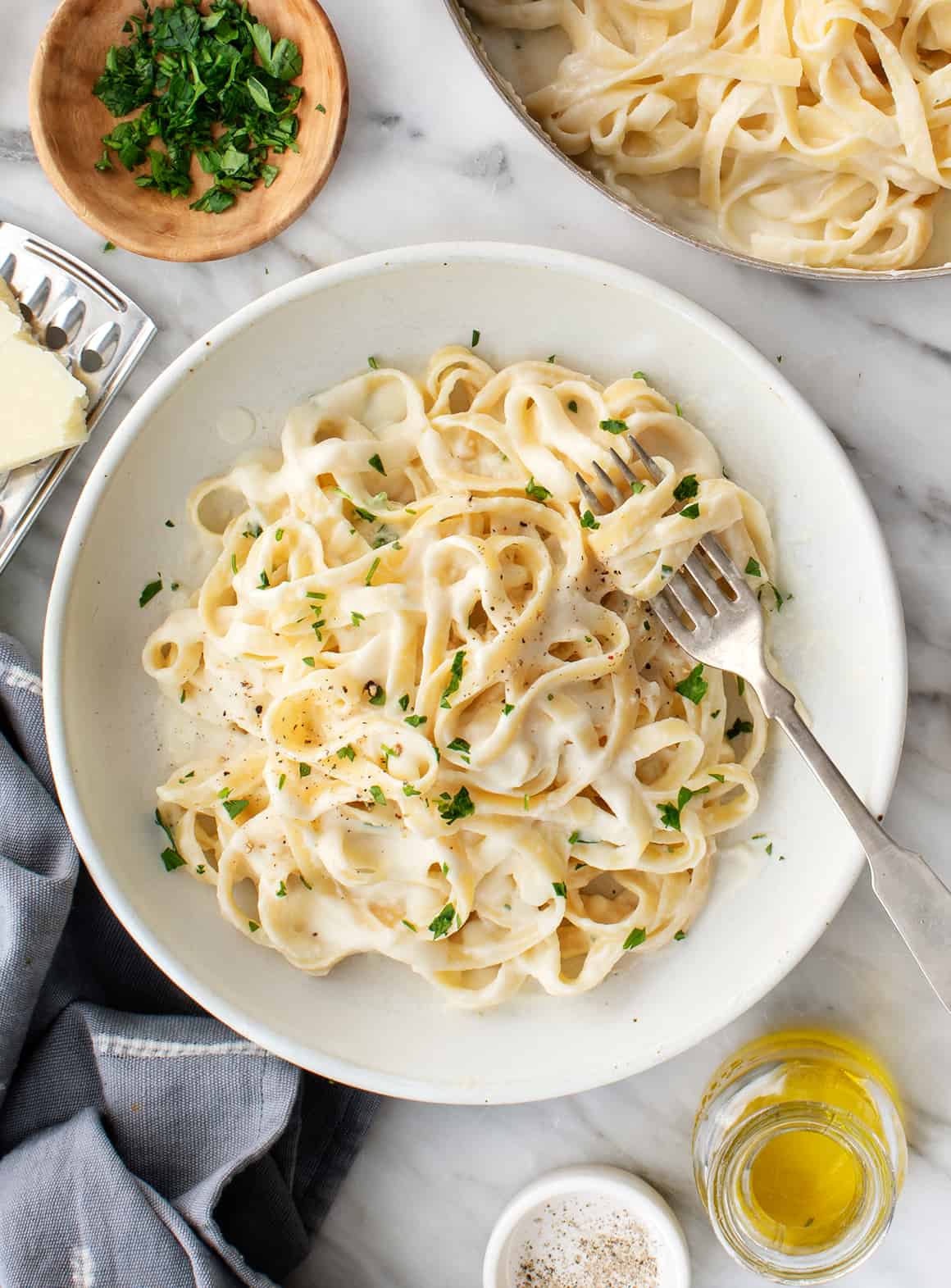
Importance of Protein and Vegetables:
- Nutritional Boost: Incorporating protein sources like chicken, shrimp, or ground turkey, as well as vegetables like broccoli, peas, or bell peppers, adds essential nutrients to the dish, making it more balanced and wholesome.
- Texture Enhancement: Protein and vegetables contribute to a diverse texture profile, adding crunch, tenderness, or juiciness to the sauce. This creates a more dynamic eating experience and enhances overall satisfaction.
- Flavor Variation: Protein and vegetables introduce new flavor elements to the sauce, from the savory umami of chicken to the sweetness of bell peppers. This variety adds complexity and depth to the Alfredo sauce, making it more interesting and enjoyable.
Incorporation Techniques:
- Preparation Methods: Cook protein sources and vegetables separately before adding them to the sauce. This allows for better control over cooking times and ensures that each ingredient retains its texture and flavor integrity.
- Simmering: Simmer the protein and vegetables in the Alfredo sauce for a few minutes to allow the flavors to meld together. This also ensures that the ingredients are evenly coated in the sauce, enhancing their flavor absorption.
- Layering: Layer protein and vegetables over cooked pasta before pouring the Alfredo sauce on top. This creates a visually appealing presentation and allows diners to customize their dish by mixing in the desired amount of sauce.
Flavor Impact:
- Depth and Complexity: Protein and vegetables add depth and complexity to the Alfredo sauce, elevating its flavor profile to new heights. The combination of savory protein, sweet vegetables, and creamy sauce creates a harmonious blend of flavors that tantalizes the taste buds.
- Balanced Taste: Protein and vegetables help balance the richness of the Alfredo sauce by providing contrasting flavors and textures. This prevents the sauce from feeling heavy or overwhelming and creates a more well-rounded taste experience.
Usage Tips:
- Protein Selection: Choose protein sources that complement the flavors of the Alfredo sauce and your personal taste preferences. Chicken, shrimp, and Italian sausage are popular choices, but you can also use tofu or plant-based meat alternatives for a vegetarian option.
- Vegetable Variety: Experiment with a variety of vegetables to add color, flavor, and nutritional diversity to the dish. Consider seasonal options like asparagus in spring, zucchini in summer, or butternut squash in fall for a fresh and vibrant twist.
- Cooking Timing: Be mindful of cooking times when adding protein and vegetables to the sauce. Overcooked protein can become tough and dry, while overcooked vegetables can become mushy and lose their vibrant color and flavor.
Culinary Creativity:
- Customization: Encourage diners to customize their Alfredo sauce by offering a variety of protein and vegetable options. Create a “build-your-own” Alfredo bar with an assortment of toppings and let guests create their perfect pasta dish.
- Global Inspiration: Draw inspiration from global cuisines when selecting protein and vegetable additions. Consider adding Indian-spiced chicken tikka or Thai-inspired tofu and vegetables for a flavorful and exotic twist.
- Leftover Reinvention: Use leftover cooked protein and vegetables to create a quick and easy Alfredo sauce variation. Simply toss the leftovers with jarred Alfredo sauce and cooked pasta for a delicious meal with minimal effort.
Fine-Tuning Your Creation
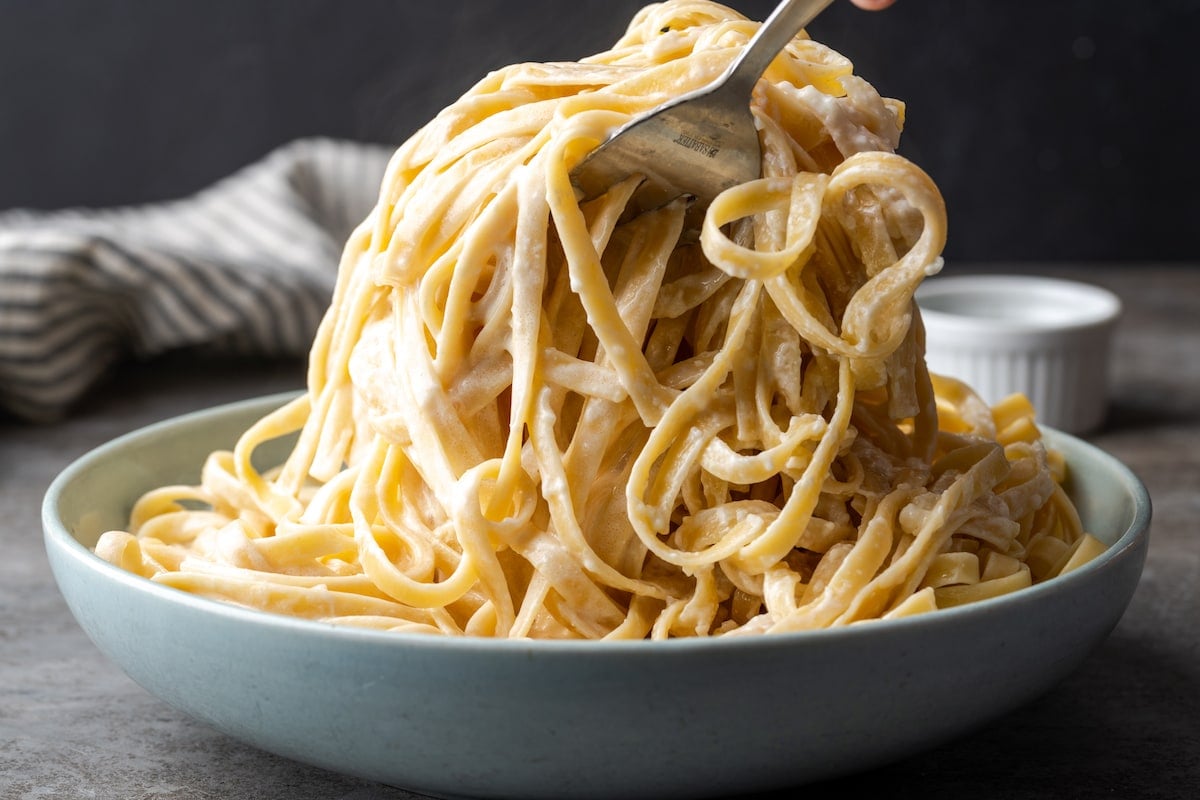
Flavor Adjustment:
- Taste Testing: Regularly taste the sauce throughout the cooking process to assess its flavor profile and identify any areas that need adjustment. Use a spoon to sample the sauce, paying attention to its richness, saltiness, and overall balance.
- Seasoning: Adjust the seasoning as needed by adding salt, pepper, or additional herbs and spices to enhance the flavor of the sauce. Start with small amounts and gradually increase until the desired taste is achieved, being careful not to over-season.
- Acidity: Consider adding a splash of lemon juice or a dash of vinegar to brighten the flavors of the sauce and balance its richness. The acidity helps cut through the creaminess of the sauce, adding a refreshing tang that elevates the overall taste experience.
Texture Refinement:
- Consistency: Evaluate the consistency of the sauce and adjust as needed to achieve the desired thickness and creaminess. If the sauce is too thick, add a splash of milk or cream to thin it out. If it’s too thin, simmer it uncovered to reduce and thicken.
- Smoothness: Strive for a smooth and velvety texture by ensuring that the sauce is free of lumps and clumps. Use a whisk or immersion blender to blend the sauce until smooth, if necessary, ensuring a silky consistency that coats the pasta evenly.
- Creaminess: Enhance the creaminess of the sauce by adding additional butter, cream, or cheese, if desired. These ingredients contribute richness and depth of flavor while creating a luxurious mouthfeel that lingers on the palate.
Balance Adjustment:
- Richness: Achieve a balanced level of richness by adjusting the proportions of butter, cream, and cheese in the sauce. Aim for a harmonious blend of flavors that is neither too heavy nor too light, striking the perfect balance of indulgence and satisfaction.
- Savoriness: Enhance the savory notes of the sauce by incorporating umami-rich ingredients like Parmesan cheese, mushrooms, or soy sauce. These ingredients add depth and complexity to the sauce, elevating its overall savoriness and appeal.
- Sweetness: Balance the sweetness of the sauce by adding a pinch of sugar or honey, if necessary. This helps counteract any overly sweet or cloying flavors, ensuring a more balanced and nuanced taste profile.
Personalization:
- Customization: Tailor the sauce to your personal taste preferences by experimenting with different ingredients and flavor combinations. Whether you prefer a classic Parmesan-heavy sauce or a lighter, herb-infused variation, fine-tuning allows you to create a sauce that suits your palate perfectly.
- Creative Additions: Get creative with your sauce by adding unique ingredients like sun-dried tomatoes, roasted garlic, or caramelized onions for extra flavor and texture. These additions add depth and complexity to the sauce, making it truly your own creation.
- Presentation: Consider the visual presentation of the sauce and garnish it with fresh herbs, grated cheese, or a drizzle of olive oil before serving. Not only does this enhance the overall aesthetic appeal of the dish, but it also adds a final touch of flavor and elegance.
Homemade Alfredo Sauce Recipe

Ingredients:
-
- 2 tablespoons butter (not margarine)
- 2 tablespoons minced garlic
- 15-ounce jar of Alfredo sauce
- 1/2 cup heavy cream
- 1 tablespoon Italian seasoning
- 1/4 cup freshly shredded Parmesan
Instructions:
- Melt the Butter: In a saucepan over medium heat, melt the butter until it begins to sizzle and foam.
- Sauté the Garlic: Add the minced garlic to the melted butter and sauté for 1-2 minutes, or until fragrant. Be careful not to let the garlic brown or burn, as it can become bitter.
- Add the Heavy Cream: Pour the heavy cream into the saucepan with the melted butter and garlic, stirring continuously to combine.
- Simmer the Sauce: Allow the sauce to simmer gently over medium-low heat for 5-7 minutes, or until it begins to thicken slightly. Stir occasionally to prevent scorching.
- Incorporate the Parmesan Cheese: Gradually add the grated Parmesan cheese to the sauce, stirring constantly until it is fully melted and incorporated. Continue to simmer the sauce for an additional 2-3 minutes, or until it reaches your desired consistency.
- Season to Taste: Taste the sauce and adjust the seasoning as needed with salt and freshly ground black pepper. Remember that Parmesan cheese is naturally salty, so you may not need to add much additional salt.
- Serve Immediately: Once the sauce has reached the desired consistency and flavor, remove it from the heat and serve it immediately over cooked pasta of your choice. Garnish with additional grated Parmesan cheese and freshly chopped parsley, if desired.
Tips:
- Quality Ingredients: Use high-quality butter, heavy cream, and Parmesan cheese for the best flavor and texture in your Alfredo sauce.
- Consistent Stirring: Stir the sauce continuously while cooking to prevent it from sticking to the bottom of the saucepan and ensure that it heats evenly.
- Adjust Consistency: If the sauce becomes too thick, you can thin it out with a splash of milk or chicken broth. Alternatively, if it’s too thin, simmer it for a few additional minutes to reduce and thicken.
- Customization: Feel free to customize the sauce by adding additional ingredients such as cooked chicken, shrimp, or vegetables to create your own unique variations.
Conclusion
With the techniques and enhancements outlined in this guide, you can elevate jarred Alfredo sauce from a convenient pantry staple to a culinary masterpiece. Whether you’re craving a quick weeknight meal or entertaining guests, these tips will help you create a dish that’s sure to impress. So go ahead, unleash your creativity, and let your taste buds embark on a journey of flavor and indulgence. Happy cooking!


